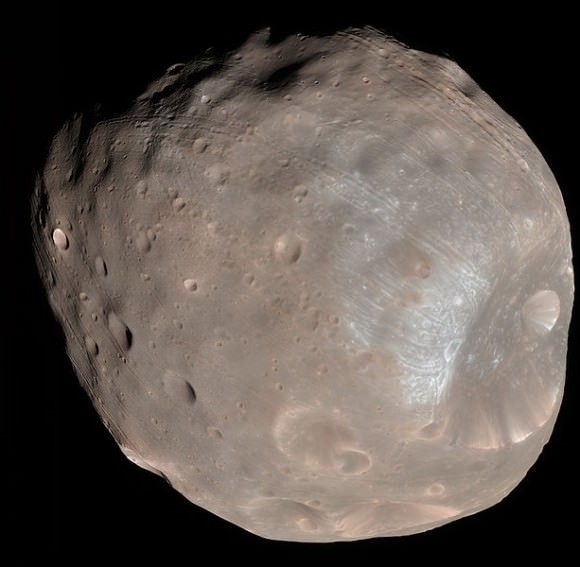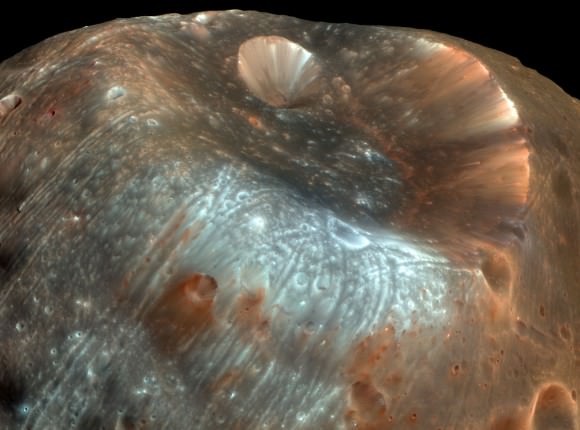Hubble Sees Tiny Phobos Orbiting Mars:
Mars’ moon Phobos is a pretty fascinating customer! Compared to Mars other moon Deimos, Phobos (named after the Greek personification of fear) is the larger and innermost satellite of the Red Planet. Due to its rapid orbital speed, the irregularly-shaped moon orbits Mars once every 7 hours, 39 minutes, and 12 seconds. In other words, it completes over three orbits of Mar within a single Earth day.
It’s not too surprising then that during a recent observation of Mars with the Hubble space telescope, Phobos chose to photobomb the picture! It all took place in May of 2016, when while Mars was near opposition and Hubble was trained on the Red Planet to take advantage of it making its closest pass to Earth in over a decade. The well-timed sighting also led to the creation of a time-lapse video that shows the moon’s orbital path.
During an opposition, Mars and Earth are at the closest points in their respective orbits to each other. Because Mars and the Sun appear to be on directly opposite sides of Earth, the term “opposition” is used. These occur every 26 months, and once every 15 to 17 years, an opposition will coincide with Mars being at the closest point in its orbit to the Sun (perihelion).
When this happens, Mars is especially close to Earth, which makes it an ideal occasion to photograph it. The last time this occurred was on May 22nd, 2016, when Mars was and Earth were at a distance of about 76,309,874 km (47,416,757 mi or 0.5101 AU) from each other. This would place it closer to Earth than it had been in 11 years, and the Hubble space telescope was trained on Mars to take advantage of this.
A few days before Mars made its closest pass, Hubble took 13 separate exposures of the planet over the course of 22 minutes, allowing astronomers to create a time-lapse video. This worked out well, since Phobos came into view during the exposures, which led the video showing the path of the moon’s orbit. Because of its small size, Phobos looked like a star that was popping out from behind the planet.
This sighting has only served to enhance Phobos’ fascinating nature. As of 2017, astronomers have been aware of the moon’s existence for 140 years. It was discovered in 1877, when Asaph Hall – while searching for Martian moons – observed it from the U.S. Naval Observatory in Washington D.C. A few days later, he also discovered Deimos, the smaller, outer moon of Mars.
In July of 1969, just two weeks before the Apollo landing, the Mariner 7 probe conducted a flyby of Mars and took the first close-up images of the Moon. In 1977, a year after the Viking 1 lander was deployed to the Martian surface, NASA’s Viking 1 orbiter took the first detailed photographs of the moon. These revealed a cratered surface marred by long, shallow grooves and one massive crater – known as the Stickney crater.
Asaph Hall named this crater after Chloe Angeline Stickney Hall (his wife) after discovering it in 1878, a year after he discovered Phobos and Deimos. Measuring some 10 km in diameter – almost half of the average diameter of Phobos itself – the impact that created Stickney is believed to have been so powerful that it nearly shattered the moon.
The most widely-accepted theory about Phobos origins is that both it and Deimos were once asteroids that were kicked out of the Main Belt by Jupiter’s gravity, and were then acquired by Mars. But unlike Deimos, Phobos’ orbit is unstable. Every century, the moon draws closer to Mars by about 1.98 meters (6.5 feet). At this rate, scientist estimate that within 30 to 50 million years, it will crash into Mars or be torn to pieces to form a ring in orbit.
This viewing is perhaps a reminder that this satellite won’t be with Mars forever. Then again, it will certainly still be there if and when astronauts (and maybe even colonists) begin setting foot on the planet. To these people, looking up at the sky from the surface of Mars, Phobos will be seen regularly eclipsing the Sun. Because of its small size, it does not fully eclipse the Sun, but it does make transits multiple times in a single day.
So there’s still plenty of time to study and enjoy this fearfully-named moon. And while you’re at it, be sure to check out the video below, courtesy of NASA’s Goddard Space Center!
Further Reading: HubbleSite, NASA
The post Hubble Sees Tiny Phobos Orbiting Mars appeared first on Universe Today.
Photos of Nature, Nature Photography Across The Universe. All about Nature, Love, Travel, Beautiful Photo, Landscape, Sunset, Summer, Mountains, Flowers, Photographer, Wallpaper, Portrait, Photo, what is the Universe
Photos of Nature | Nature Photography What is The Universe
Sunday, July 30, 2017
Subscribe to:
Post Comments (Atom)


No comments:
Post a Comment